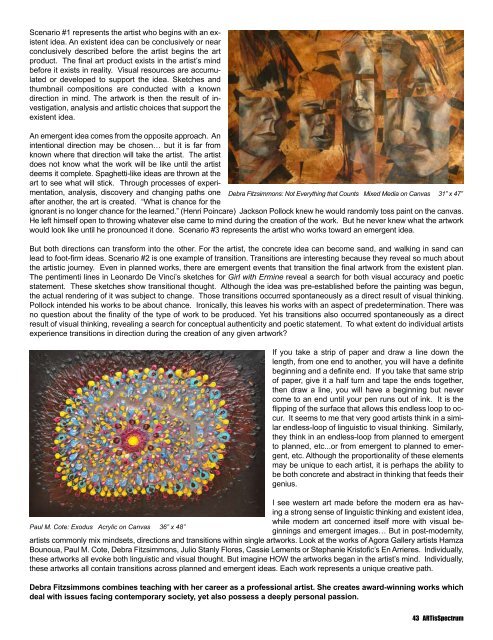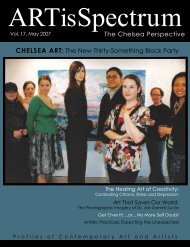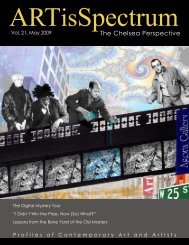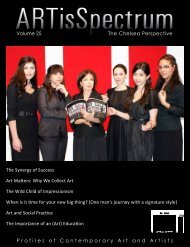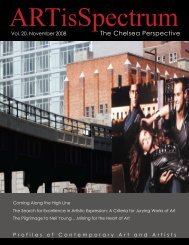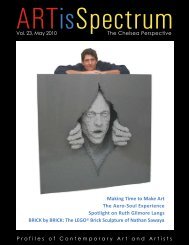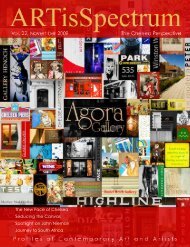Download PDF - ARTisSpectrum
Download PDF - ARTisSpectrum
Download PDF - ARTisSpectrum
- No tags were found...
Create successful ePaper yourself
Turn your PDF publications into a flip-book with our unique Google optimized e-Paper software.
Scenario #1 represents the artist who begins with an existentidea. An existent idea can be conclusively or nearconclusively described before the artist begins the artproduct. The final art product exists in the artist’s mindbefore it exists in reality. Visual resources are accumulatedor developed to support the idea. Sketches andthumbnail compositions are conducted with a knowndirection in mind. The artwork is then the result of investigation,analysis and artistic choices that support theexistent idea.An emergent idea comes from the opposite approach. Anintentional direction may be chosen… but it is far fromknown where that direction will take the artist. The artistdoes not know what the work will be like until the artistdeems it complete. Spaghetti-like ideas are thrown at theart to see what will stick. Through processes of experimentation,analysis, discovery and changing paths oneafter another, the art is created. “What is chance for theDebra Fitzsimmons: Not Everything that Counts Mixed Media on Canvas 31” x 47”ignorant is no longer chance for the learned.” (Henri Poincare) Jackson Pollock knew he would randomly toss paint on the canvas.He left himself open to throwing whatever else came to mind during the creation of the work. But he never knew what the artworkwould look like until he pronounced it done. Scenario #3 represents the artist who works toward an emergent idea.But both directions can transform into the other. For the artist, the concrete idea can become sand, and walking in sand canlead to foot-firm ideas. Scenario #2 is one example of transition. Transitions are interesting because they reveal so much aboutthe artistic journey. Even in planned works, there are emergent events that transition the final artwork from the existent plan.The pentimenti lines in Leonardo De Vinci’s sketches for Girl with Ermine reveal a search for both visual accuracy and poeticstatement. These sketches show transitional thought. Although the idea was pre-established before the painting was begun,the actual rendering of it was subject to change. Those transitions occurred spontaneously as a direct result of visual thinking.Pollock intended his works to be about chance. Ironically, this leaves his works with an aspect of predetermination. There wasno question about the finality of the type of work to be produced. Yet his transitions also occurred spontaneously as a directresult of visual thinking, revealing a search for conceptual authenticity and poetic statement. To what extent do individual artistsexperience transitions in direction during the creation of any given artwork?If you take a strip of paper and draw a line down thelength, from one end to another, you will have a definitebeginning and a definite end. If you take that same stripof paper, give it a half turn and tape the ends together,then draw a line, you will have a beginning but nevercome to an end until your pen runs out of ink. It is theflipping of the surface that allows this endless loop to occur.It seems to me that very good artists think in a similarendless-loop of linguistic to visual thinking. Similarly,they think in an endless-loop from planned to emergentto planned, etc...or from emergent to planned to emergent,etc. Although the proportionality of these elementsmay be unique to each artist, it is perhaps the ability tobe both concrete and abstract in thinking that feeds theirgenius.Paul M. Cote: Exodus Acrylic on Canvas 36” x 48”I see western art made before the modern era as havinga strong sense of linguistic thinking and existent idea,while modern art concerned itself more with visual beginningsand emergent images… But in post-modernity,artists commonly mix mindsets, directions and transitions within single artworks. Look at the works of Agora Gallery artists HamzaBounoua, Paul M. Cote, Debra Fitzsimmons, Julio Stanly Flores, Cassie Lements or Stephanie Kristofic’s En Arrieres. Individually,these artworks all evoke both linguistic and visual thought. But imagine HOW the artworks began in the artist’s mind. Individually,these artworks all contain transitions across planned and emergent ideas. Each work represents a unique creative path.Debra Fitzsimmons combines teaching with her career as a professional artist. She creates award-winning works whichdeal with issues facing contemporary society, yet also possess a deeply personal passion.43 <strong>ARTisSpectrum</strong>


